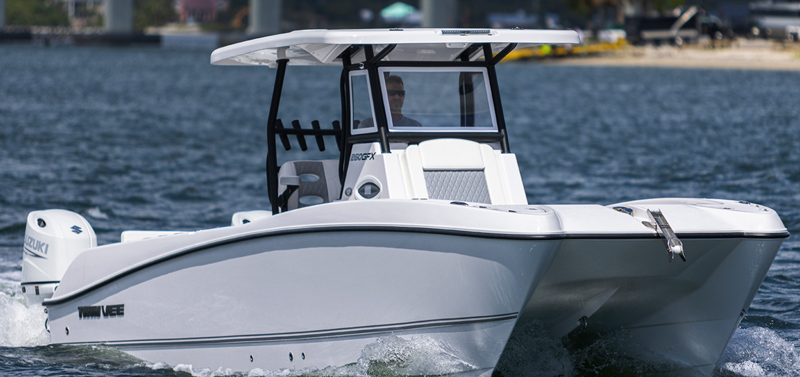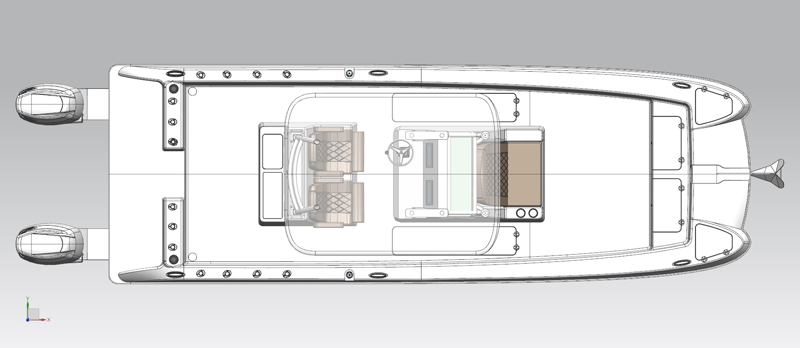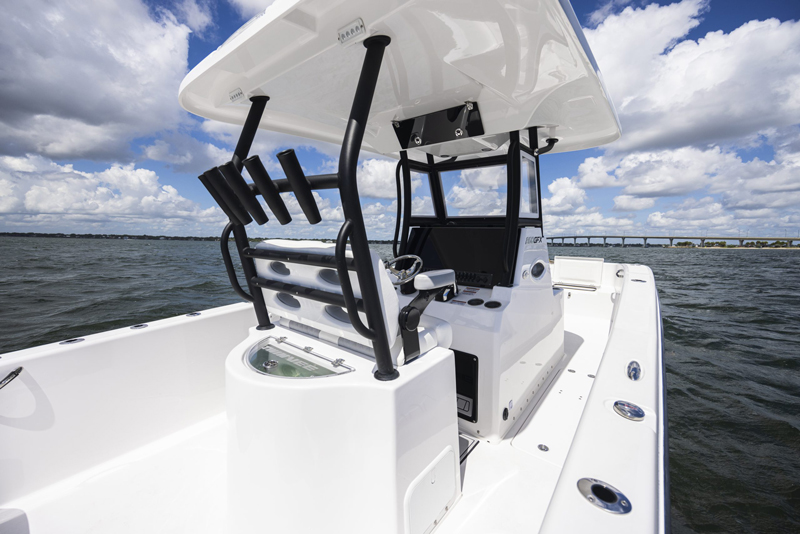What size center console fishing boat is ideal for you and your needs? That depends on who you are and what waters you fish in, but for a huge swath of anglers out there, a 26-footer will sit right in the sweet spot. Boats in this size range are big enough to handle open seas, small enough to trailer up and down the coast, and have the draft and range to get you to the fish both inshore and offshore. There’s just one fly in this angling ointment: most 26-foot center console boats feel pretty darn small when the seas are kicking, and can leave you soaked, battered, and bruised if you face a long run through open ocean after the winds pick up. Unless, that is, you’re on a boat like the Twin Vee 26 CC GFX.

Spend a season fishing aboard a well-designed powercat like the 260 CC GFX, and by the end of it you’ll swear it runs more comfortably than many 30-plus-foot monohulls. A pair of razor-sharp entries at the bow slice open waves while reducing impact area, and the tunnel in-between those bows compress air as the boat moves forward to cushion what impacts there are. Net result? When it comes to riding smoothly through the waves a similarly sized monohull simply can’t compare.
Just the Facts, Ma’am
That may sound a bit like the recitation of marketing blather, but the difference in impact severity between cats and monohulls has been objectively proven via testing with accelerometers in boats run side-by-side through identical conditions. Net reduction in impacts amounted to around 50 percent, with some variation depending on the direction the boats were traveling in. When hitting waves head-on, G-force impact was reduced from three Gs to four Gs and deceleration increased from 0.081 to 0.287 seconds. Naturally, this effect may be enhanced or reduced by factors like load, weight distribution, speed, and differences in different hull designs. But when all is said and done, foot for foot a cat can smooth out the bumps better than a monohull can. Period.
Stalking the Seas
Of course, there’s no substitute for experiencing the difference for yourself. And all boats have different plusses and minuses in the way they ride and handle. So we’d never ask anyone to take our word for it, and instead simply ask that you keep an open mind — and step aboard a 260 GFX for a sea trial of your own. Preferably, when the wind is kicking. When you do go for that test run you’ll discover that this Twin Vee is, like most of their models, armed to the teeth to go on the hunt for everything from snook to swordfish. There’s a 30-gallon livewell in the back of the leaning post, a pair of insulated and macerated fishboxes in the deck, and standard-issue items include fresh and raw water washdowns, a tackle station with eight Plano boxes and leader stowage, and rod/gaff/mop racks under the gunwales. What about rodholders? Prepare yourself. Unlike most builders, who pop in four or six gunwale holders then charge you extra to add all the rodholders you really want, Twin Vee includes 18 stainless-steel rod holders as standard equipment.

It's also critical to note that the livewell and fishbox placement allows anglers to get all the way aft and right up to the narrow transom when fighting a fish. Many of today’s center consoles bloat the transom by incorporating livewells and fishboxes, forcing the angler farther forward in the boat. Particularly when fighting large pelagics, this can make landing fish more difficult and working fish around the outboards riskier. And as for those days when you’ll be casting rather than trolling, also notice that the 260 CC GFX carries its beam all the way forward up to the bow. This is another classic cat advantage, in that it significantly boosts bow cockpit space.
Comfort Zone
This model is a serious fishing machine, and hard-core anglers will love that Twin Vee doesn’t chop into the deck space with a bunch of extra molded-in seating units or dinette tables. The deck is wide-open and uncluttered both fore and aft. But that doesn’t mean Twin Vee didn’t add a few touches to keep everyone comfortable aboard. They put anti-fatigue foam padding at the helm deck and footrest, and that helm now sports a three-sided enclosure, a nice improvement over the older GF model’s single windscreen. The Llebroc helm seats have flip-down arm rests and flip-up bolsters, another serious improvement over opting to use something like an old-school leaning post. There’s also a head inside the console, USB and 12-V ports at the switch panel, and a pull-out freshwater shower by the swim platform.

Still, setting all that aside the most comfortable spot on this boat is bound to be the double-wide forward console seat. It’s more lounger than seat, and is contoured for comfort with integrated arm rests and cupholders.
Remember, those added touches might be nice but the biggest comfort boost of all comes from the smooth ride. And whatever fishing spot you head for, you’ll discover that it’s a going to be a sweet one standing on the deck of a Twin Vee 260 CC GFX.
Twin Vee 260 CC GFX Specifications
- LOA: 26’0”
- Beam: 8’8”
- Draft (min.): 1’6”
- Fuel Capacity: 150 gallons
- Max. Power: 400 hp